Panasonic FZ80 vs TS7
The Panasonic Lumix DC-FZ80 (called Panasonic FZ82 in some regions) and the Panasonic Lumix DC-TS7 (labelled Panasonic FT7 in some countries) are two digital cameras that were revealed to the public, respectively, in January 2017 and May 2018. Both the FZ80 and the TS7 are fixed lens compact cameras that are equipped with a 1/2.3-inch sensor. The FZ80 has a resolution of 18 megapixels, whereas the TS7 provides 20.2 MP.
Below is an overview of the main specs of the two cameras as a starting point for the comparison.

Check FZ80 offers at
ebay.com

Check TS7 offers at
ebay.com
Going beyond this snapshot of core features and characteristics, what are the differences between the Panasonic Lumix DC-FZ80 and the Panasonic Lumix DC-TS7? Which one should you buy? Read on to find out how these two cameras compare with respect to their body size, their imaging sensors, their shooting features, their input-output connections, and their reception by expert reviewers.
Body comparison
The side-by-side display below illustrates the physical size and weight of the Panasonic FZ80 and the Panasonic TS7. The two cameras are presented according to their relative size. Three successive views from the front, the top, and the rear are shown. All size dimensions are rounded to the nearest millimeter.
The TS7 can be obtained in three different colors (black, blue, orange), while the FZ80 is only available in black.
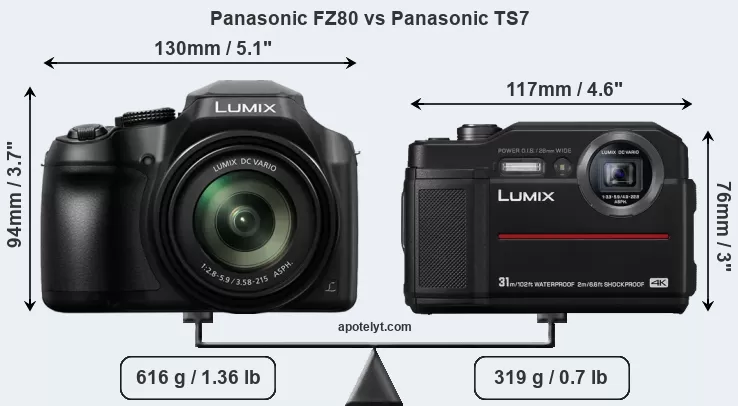
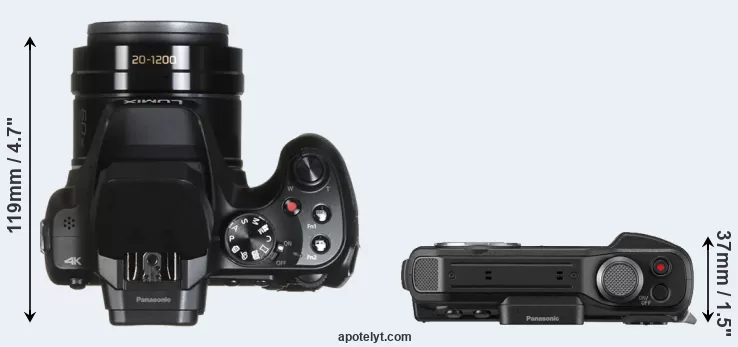
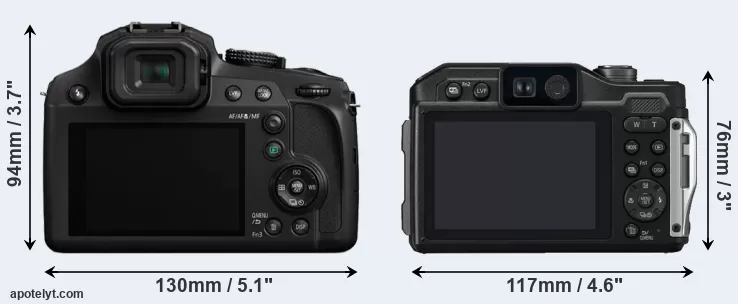
If the front view area (width x height) of the cameras is taken as an aggregate measure of their size, the Panasonic TS7 is notably smaller (27 percent) than the Panasonic FZ80. Moreover, the TS7 is substantially lighter (48 percent) than the FZ80. It is noteworthy in this context that the TS7 is splash and dust-proof, while the FZ80 does not feature any corresponding weather-sealing. More than that, the TS7 is water-proof up to 31m and can, thus, be used for underwater photography.
Concerning battery life, the FZ80 gets 330 shots out of its Panasonic DMW-BMB9 battery, while the TS7 can take 300 images on a single charge of its Panasonic DMW-BCM13 power pack. The battery packs of both cameras can be charged via USB, which can be very convenient when travelling.
The following table provides a synthesis of the main physical specifications of the two cameras and other similar ones. In case you want to display and compare another camera duo, you can use the CAM-parator app to select your camera combination among a large number of options.

| Camera Model |
Camera Width |
Camera Height |
Camera Depth |
Camera Weight |
Battery Life |
Weather Sealing |
Camera Launch |
Launch Price (USD) |
Street Price |
||
|---|---|---|---|---|---|---|---|---|---|---|---|
| 1. | Panasonic FZ80 | 130 mm | 94 mm | 119 mm | 616 g | 330 | n | Jan 2017 | 399 | ebay.com | |
| 2. | Panasonic TS7 | 117 mm | 76 mm | 37 mm | 319 g | 300 | Y | May 2018 | 449 | ebay.com | |
| 3. | Canon SX70 | 127 mm | 91 mm | 117 mm | 608 g | 325 | n | Sep 2018 | 549 | amazon.com | |
| 4. | Canon SX730 | 110 mm | 64 mm | 40 mm | 300 g | 250 | n | Apr 2017 | 399 | ebay.com | |
| 5. | Canon SX740 | 110 mm | 64 mm | 40 mm | 299 g | 265 | n | Jul 2018 | 399 | amazon.com | |
| 6. | Panasonic ZS70 | 112 mm | 67 mm | 41 mm | 322 g | 380 | n | Apr 2017 | 449 | ebay.com | |
| 7. | Panasonic ZS80 | 112 mm | 69 mm | 42 mm | 327 g | 380 | n | Feb 2019 | 449 | ebay.com | |
| 8. | Ricoh WG-6 | 118 mm | 66 mm | 33 mm | 246 g | 340 | Y | Feb 2019 | 399 | amazon.com | |
| 9. | Sony HX95 | 102 mm | 58 mm | 36 mm | 242 g | 370 | n | Aug 2018 | 429 | ebay.com | |
| 10. | Sony HX99 | 102 mm | 58 mm | 36 mm | 242 g | 370 | n | Aug 2018 | 449 | ebay.com | |
| 11. | Sony HX350 | 130 mm | 93 mm | 103 mm | 652 g | 300 | n | Dec 2016 | 449 | ebay.com | |
| 12. | Sony WX800 | 102 mm | 58 mm | 36 mm | 233 g | 370 | n | Oct 2018 | 399 | ebay.com | |
| Note: Measurements and pricing do not include easily detachable parts, such as add-on or interchangeable lenses or optional viewfinders. | |||||||||||
The price is, of course, an important factor in any camera decision. The manufacturer’s suggested retail prices give an idea on the placement of the camera in the maker’s lineup and the broader market. The FZ80 was launched at a somewhat lower price (by 11 percent) than the TS7, which makes it more attractive for photographers on a tight budget. Usually, retail prices stay at first close to the launch price, but after several months, discounts become available. Later in the product cycle and, in particular, when the replacement model is about to appear, further discounting and stock clearance sales often push the camera price considerably down.
Sensor comparison
The size of the sensor inside a digital camera is one of the key determinants of image quality. A large sensor will tend to have larger individual pixels that provide better low-light sensitivity, wider dynamic range, and richer color-depth than smaller pixel-units in a sensor of the same technological generation. Moreover, a large sensor camera will give the photographer more control over depth-of-field in the image and, thus, the ability to better isolate a subject from the background. On the downside, larger sensors are more costly to manufacture and tend to lead to bigger and heavier cameras and lenses.
Both cameras under consideration feature a 1/2.3-inch sensor and have a format factor (sometimes also referred to as "crop factor") of 5.6. Within the spectrum of camera sensors, this places the review cameras among the smaller-sensor digicams that favor affordability and compact design. Both cameras feature a native aspect ratio (sensor width to sensor height) of 4:3.
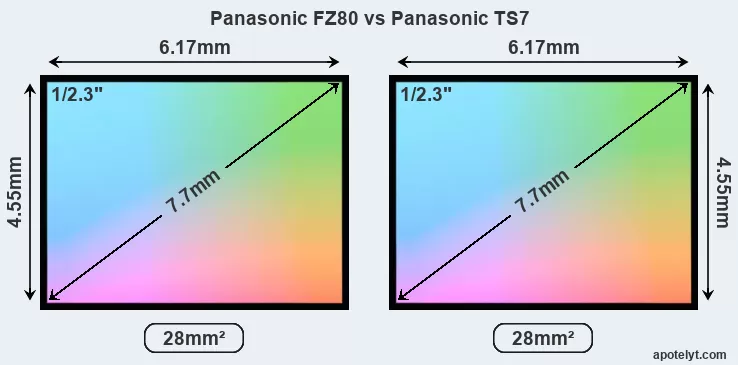
While the two cameras under review share the same sensor size, the TS7 offers a higher resolution of 20.2 megapixels, compared with 18 MP of the FZ80. This megapixels advantage translates into a 6 percent gain in linear resolution. On the other hand, these sensor specs imply that the TS7 has a higher pixel density and a smaller size of the individual pixel (with a pixel pitch of 1.18μm versus 1.25μm for the FZ80). However, it should be noted that the TS7 is a somewhat more recent model (by 1 year and 4 months) than the FZ80, and its sensor might have benefitted from technological advances during this time that at least partly compensate for the smaller pixel size. Coming back to sensor resolution, it should be mentioned that the FZ80 has no anti-alias filter installed, so that it can capture all the detail its sensor resolves.
The resolution advantage of the Panasonic TS7 implies greater flexibility for cropping images or the possibility to print larger pictures. The maximum print size of the TS7 for good quality output (200 dots per inch) amounts to 25.9 x 19.4 inches or 65.8 x 49.4 cm, for very good quality (250 dpi) 20.7 x 15.6 inches or 52.7 x 39.5 cm, and for excellent quality (300 dpi) 17.3 x 13 inches or 43.9 x 32.9 cm. The corresponding values for the Panasonic FZ80 are 24.5 x 18.4 inches or 62.2 x 46.6 cm for good quality, 19.6 x 14.7 inches or 49.7 x 37.3 cm for very good quality, and 16.3 x 12.2 inches or 41.5 x 31.1 cm for excellent quality prints.
The Panasonic Lumix DC-FZ80 has a native sensitivity range from ISO 80 to ISO 3200, which can be extended to ISO 80-6400. The Panasonic Lumix DC-TS7 offers exactly the same ISO settings.
Technology-wise, both cameras are equipped with BSI-CMOS (Backside Illuminated Complementary Metal–Oxide–Semiconductor) sensors. Both cameras use a Bayer filter for capturing RGB colors on a square grid of photosensors. This arrangement is found in most digital cameras.
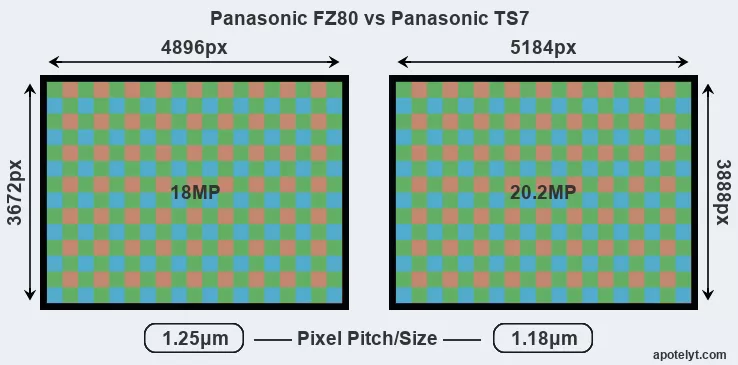
Since 2007, DXO Mark has published sensor performance measurements that have been derived using a consistent methodology. This service is based on lab testing and assigns an overall score to each camera sensor, as well as ratings for dynamic range ("DXO Landscape"), color depth ("DXO Portrait"), and low-light sensitivity ("DXO Sports"). The table below summarizes the physical sensor characteristics and sensor quality findings and compares them across a set of similar cameras.

| Camera Model |
Sensor Class |
Resolution (MP) |
Horiz. Pixels |
Vert. Pixels |
Video Format |
DXO Portrait |
DXO Landscape |
DXO Sports |
DXO Overall |
||
|---|---|---|---|---|---|---|---|---|---|---|---|
| 1. | Panasonic FZ80 | 1/2.3 | 18.0 | 4896 | 3672 | 4K/30p | 20.5 | 11.9 | 900 | 49 | |
| 2. | Panasonic TS7 | 1/2.3 | 20.2 | 5184 | 3888 | 4K/30p | 20.6 | 12.1 | 1028 | 51 | |
| 3. | Canon SX70 | 1/2.3 | 20.2 | 5184 | 3888 | 4K/30p | 20.6 | 12.1 | 1063 | 51 | |
| 4. | Canon SX730 | 1/2.3 | 20.2 | 5184 | 3888 | 1080/60p | 20.5 | 11.9 | 924 | 50 | |
| 5. | Canon SX740 | 1/2.3 | 20.2 | 5184 | 3888 | 4K/30p | 20.6 | 12.1 | 1050 | 51 | |
| 6. | Panasonic ZS70 | 1/2.3 | 20.2 | 5184 | 3888 | 4K/30p | 19.1 | 10.6 | 106 | 36 | |
| 7. | Panasonic ZS80 | 1/2.3 | 20.2 | 5184 | 3888 | 4K/30p | 20.7 | 12.2 | 1103 | 52 | |
| 8. | Ricoh WG-6 | 1/2.3 | 20.2 | 5184 | 3888 | 4K/30p | 20.7 | 12.2 | 1104 | 52 | |
| 9. | Sony HX95 | 1/2.3 | 18.0 | 4896 | 3672 | 4K/30p | 20.6 | 12.1 | 1057 | 51 | |
| 10. | Sony HX99 | 1/2.3 | 18.0 | 4896 | 3672 | 4K/30p | 20.6 | 12.1 | 1058 | 51 | |
| 11. | Sony HX350 | 1/2.3 | 19.9 | 5152 | 3864 | 1080/60p | 20.5 | 11.9 | 896 | 49 | |
| 12. | Sony WX800 | 1/2.3 | 18.0 | 4896 | 3672 | 4K/30p | 20.6 | 12.2 | 1070 | 51 | |
| Note: DXO values in italics represent estimates based on sensor size and age. | |||||||||||
Many modern cameras cannot only take still pictures, but also record videos. The two cameras under consideration both have sensors whose read-out speed is fast enough to capture moving pictures, and both provide the same movie specifications (4K/30p).
Feature comparison
Apart from body and sensor, cameras can and do differ across a variety of features. The two cameras under review are similar with respect to both having an electronic viewfinder. However, the one in the TS7 offers a slightly higher resolution than the one in the FZ80 (1170k vs 1166k dots). The adjacent table lists some of the other core features of the Panasonic FZ80 and Panasonic TS7 along with similar information for a selection of comparators.

| Camera Model |
Viewfinder (Type or 000 dots) |
Control Panel (yes/no) |
LCD Specifications (inch/000 dots) |
LCD Attach- ment |
Touch Screen (yes/no) |
Max Shutter Speed * |
Max Shutter Flaps * |
Built-in Flash (yes/no) |
Built-in Image Stab |
||
|---|---|---|---|---|---|---|---|---|---|---|---|
| 1. | Panasonic FZ80 | 1166 | n | 3.0 / 1040 | fixed | Y | 1/2000s | 10.0/s | Y | Y | |
| 2. | Panasonic TS7 | 1170 | n | 3.0 / 1040 | fixed | n | 1/1300s | 10.0/s | Y | Y | |
| 3. | Canon SX70 | 2360 | n | 3.0 / 922 | swivel | n | 1/2000s | 10.0/s | Y | Y | |
| 4. | Canon SX730 | none | n | 3.0 / 922 | tilting | n | 1/3200s | 5.9/s | Y | Y | |
| 5. | Canon SX740 | none | n | 3.0 / 922 | tilting | n | 1/3200s | 10.0/s | Y | Y | |
| 6. | Panasonic ZS70 | 1166 | n | 3.0 / 1040 | tilting | Y | 1/2000s | 10.0/s | Y | Y | |
| 7. | Panasonic ZS80 | 2330 | n | 3.0 / 1040 | tilting | Y | 1/2000s | 10.0/s | Y | Y | |
| 8. | Ricoh WG-6 | none | n | 3.0 / 1040 | fixed | n | 1/4000s | 1.0/s | Y | n | |
| 9. | Sony HX95 | 638 | n | 3.0 / 922 | tilting | n | 1/2000s | 10.0/s | Y | Y | |
| 10. | Sony HX99 | 638 | n | 3.0 / 922 | tilting | Y | 1/2000s | 10.0/s | Y | Y | |
| 11. | Sony HX350 | 202 | n | 3.0 / 922 | tilting | n | 1/4000s | 10.0/s | Y | Y | |
| 12. | Sony WX800 | none | n | 3.0 / 922 | tilting | Y | 1/2000s | 10.0/s | Y | Y | |
| Note: *) Information refers to the mechanical shutter, unless the camera only has an electronic one. | |||||||||||
One differentiating feature between the two cameras concerns the touch sensitivity of the rear screen. The FZ80 has a touchscreen, while the TS7 has a conventional panel. Touch control can be particularly helpful, for example, for setting the focus point.
The reported shutter speed information refers to the use of the mechanical shutter. Yet, some cameras only have an electronic shutter, while others have an electronic shutter in addition to a mechanical one. In fact, both cameras under consideration feature an electronic shutter, which makes completely silent shooting possible. However, this mode is less suitable for photographing moving objects (risk of rolling shutter) or shooting under artificial light sources (risk of flickering).
Both the FZ80 and the TS7 have zoom lenses built in. The FZ80 has a 20-1200mm f/2.8-5.9 optic and the TS7 offers a 28-128mm f/3.3-5.9 (focal lengths in full frame equivalent terms). Hence, the FZ80 provides a wider angle of view at the short end, as well as more tele-photo reach at the long end than the TS7. The FZ80 offers the faster maximum aperture.
Concerning the storage of imaging data, both the FZ80 and the TS7 write their files to SDXC cards. Both cameras can use UHS-I cards, which provide for Ultra High Speed data transfer of up to 104 MB/s.
Connectivity comparison
For some imaging applications, the extent to which a camera can communicate with its environment can be an important aspect in the camera decision process. The table below provides an overview of the connectivity of the Panasonic Lumix DC-FZ80 and Panasonic Lumix DC-TS7 and, in particular, the interfaces the cameras (and selected comparators) provide for accessory control and data transfer.

| Camera Model |
Hotshoe Port |
Internal Mic / Speaker |
Microphone Port |
Headphone Port |
HDMI Port |
USB Port |
WiFi Support |
NFC Support |
Bluetooth Support |
||
|---|---|---|---|---|---|---|---|---|---|---|---|
| 1. | Panasonic FZ80 | Y | stereo / mono | - | - | micro | 2.0 | Y | - | - | |
| 2. | Panasonic TS7 | - | stereo / mono | - | - | micro | 2.0 | Y | - | - | |
| 3. | Canon SX70 | - | stereo / mono | Y | - | micro | 2.0 | Y | - | Y | |
| 4. | Canon SX730 | - | stereo / mono | - | - | micro | 2.0 | Y | Y | Y | |
| 5. | Canon SX740 | - | stereo / mono | - | - | micro | 2.0 | Y | - | Y | |
| 6. | Panasonic ZS70 | - | stereo / mono | - | - | micro | 2.0 | Y | - | - | |
| 7. | Panasonic ZS80 | - | stereo / mono | - | - | micro | 2.0 | Y | - | Y | |
| 8. | Ricoh WG-6 | - | mono / mono | - | - | micro | 3.0 | - | - | - | |
| 9. | Sony HX95 | - | stereo / mono | - | - | micro | 2.0 | Y | Y | Y | |
| 10. | Sony HX99 | - | stereo / mono | - | - | micro | 2.0 | Y | Y | Y | |
| 11. | Sony HX350 | - | stereo / mono | - | - | micro | 2.0 | - | - | - | |
| 12. | Sony WX800 | - | stereo / mono | - | - | micro | 2.0 | Y | Y | - |
It is notable that the FZ80 has a hotshoe, while the TS7 does not. This socket makes it possible to easily attach optional accessories, such as an external flash gun.
Both the FZ80 and the TS7 have been discontinued, but can regularly be found used on ebay. Neither of the two has a direct successor, so they represent the end of the respective camera lines from Panasonic. Further information on the features and operation of the FZ80 and TS7 can be found, respectively, in the Panasonic FZ80 Manual (free pdf) or the online Panasonic TS7 Manual.
Review summary
So what is the bottom line? Is the Panasonic FZ80 better than the Panasonic TS7 or vice versa? The listing below highlights the relative strengths of the two models.
Advantages of the Panasonic Lumix DC-FZ80:
- Maximized detail: Lacks an anti-alias filter to exploit the sensor's full resolution potential.
- Larger viewfinder image: Features a viewfinder with a higher magnification (0.46x vs 0.45x).
- Fewer buttons to press: Is equipped with a touch-sensitive rear screen to facilitate handling.
- Faster shutter: Has higher mechanical shutter speed (1/2000s vs 1/1300s) to freeze action.
- Better light gathering: Has a lens with a wider maximum aperture (f/2.8 vs f/3.3).
- Wider view: Has a wider-angle lens that facilitates landscape or interior shots.
- More tele-reach: Has a longer tele-lens for perspective compression and subject magnification.
- Better lighting: Features a hotshoe and can thus hold and trigger an external flash gun.
- More affordable: Was introduced into a lower priced segment (11 percent cheaper at launch).
- More heavily discounted: Has been on the market for longer (launched in January 2017).
Arguments in favor of the Panasonic Lumix DC-TS7:
- More detail: Has more megapixels (20.2 vs 18MP), which boosts linear resolution by 6%.
- Better moiré control: Has an anti-alias filter to avoid artificial patterns to appear in images.
- More compact: Is smaller (117x76mm vs 130x94mm) and will fit more readily into a bag.
- Less heavy: Has a lower weight (by 297g or 48 percent) and is thus easier to take along.
- Better sealing: Is splash and dust sealed for shooting in inclement weather conditions.
- Water-proof: Is rugged and sealed and can thus be used for underwater photography (up to 31m).
- More modern: Was introduced somewhat (1 year and 4 months) more recently.
If the count of relative strengths (bullet points above) is taken as a measure, the FZ80 emerges as the winner of the contest (10 : 7 points). However, the relative importance of the various individual camera aspects will vary according to personal preferences and needs, so that you might like to apply corresponding weights to the particular features before making a decision on a new camera. A professional wedding photographer will view the differences between cameras in a way that diverges from the perspective of a travel photog, and a person interested in cityscapes has distinct needs from a macro shooter. Hence, the decision which camera is best and worth buying is often a very personal one.
How about other alternatives? Do the specifications of the Panasonic FZ80 and the Panasonic TS7 place the cameras among the top in their class? Find out in the latest Best Superzoom Camera and Best Travel-Zoom Camera listings whether the two cameras rank among the cream of the crop.
In any case, while the comparison of the spec-sheets of cameras can offer a general idea of their imaging potential, it says little about, for example, the shooting experience and imaging performance of the FZ80 and the TS7 in practical situations. At times, user reviews, such as those published at amazon, address these issues in a useful manner, but such feedback is on many occasions incomplete, inconsistent, and unreliable.
Expert reviews
This is why expert reviews are important. The table below provides a synthesis of the camera assessments of some of the best known photo-gear review sites (amateurphotographer [AP], cameralabs [CL], digitalcameraworld [DCW], dpreview [DPR], ephotozine [EPZ], photographyblog [PB]). As can be seen, the professional reviewers agree in many cases on the quality of different cameras, but sometimes their assessments diverge, reinforcing the earlier point that a camera decision is often a very personal choice.

| Camera Model |
AP score |
CL score |
DCW score |
DPR score |
EPZ score |
PB score |
Camera Launch |
Launch Price (USD) |
Street Price |
||
|---|---|---|---|---|---|---|---|---|---|---|---|
| 1. | Panasonic FZ80 | .. | + + | .. | .. | 4.5/5 | 4.5/5 | Jan 2017 | 399 | ebay.com | |
| 2. | Panasonic TS7 | .. | + | .. | .. | .. | 3.5/5 | May 2018 | 449 | ebay.com | |
| 3. | Canon SX70 | .. | + + | 3.5/5 | .. | 3.5/5 | 3.5/5 | Sep 2018 | 549 | amazon.com | |
| 4. | Canon SX730 | .. | + | .. | .. | 4/5 | 4/5 | Apr 2017 | 399 | ebay.com | |
| 5. | Canon SX740 | .. | + | 3.5/5 | .. | 4/5 | 4/5 | Jul 2018 | 399 | amazon.com | |
| 6. | Panasonic ZS70 | .. | + + | .. | .. | 4/5 | 4/5 | Apr 2017 | 449 | ebay.com | |
| 7. | Panasonic ZS80 | .. | + + | .. | .. | 4.5/5 | .. | Feb 2019 | 449 | ebay.com | |
| 8. | Ricoh WG-6 | .. | .. | .. | .. | 3.5/5 | 3.5/5 | Feb 2019 | 399 | amazon.com | |
| 9. | Sony HX95 | .. | .. | .. | .. | .. | .. | Aug 2018 | 429 | ebay.com | |
| 10. | Sony HX99 | .. | .. | .. | .. | 4/5 | 4.5/5 | Aug 2018 | 449 | ebay.com | |
| 11. | Sony HX350 | .. | .. | .. | .. | .. | 4/5 | Dec 2016 | 449 | ebay.com | |
| 12. | Sony WX800 | .. | .. | .. | .. | .. | .. | Oct 2018 | 399 | ebay.com | |
| Note: (+ +) highly recommended; (+) recommended; (o) reviewed; (..) not available. | |||||||||||
Care should be taken when interpreting the review scores above, though. The ratings were established in reference to similarly priced cameras that were available in the market at the time of the review. Thus, a score needs to be put into the context of the launch date and the launch price of the camera, and rating-comparisons among cameras that span long time periods or concern very differently equipped models make little sense. Also, please note that some of the review sites have changed their methodology and reporting over time.

Check FZ80 offers at
ebay.com

Check TS7 offers at
ebay.com
Other camera comparisons
Did this review help to inform your camera decision process? If you would like to see a different side-by-side camera review, just use the search menu below. There is also a set of direct links to comparison reviews that other users of the CAM-parator app explored.
- Canon 20D vs Panasonic FZ80
- Canon 5D Mark II vs Panasonic TS7
- Canon 80D vs Panasonic FZ80
- Canon M5 vs Panasonic TS7
- Canon T5 vs Panasonic TS7
- Leica V-LUX 1 vs Panasonic FZ80
- Nikon D80 vs Panasonic TS7
- Olympus E-M1 II vs Panasonic TS7
- Panasonic FZ80 vs Sony A6000
- Panasonic FZ80 vs Sony A99 II
- Panasonic FZ80 vs Sony NEX-5
- Panasonic TS7 vs Sony NEX-5R
Specifications: Panasonic FZ80 vs Panasonic TS7
Below is a side-by-side comparison of the specs of the two cameras to facilitate a quick review of their differences and common features.
| Camera Model | Panasonic FZ80 | Panasonic TS7 |
|---|---|---|
| Camera Type | Fixed lens compact camera | Fixed lens compact camera |
| Camera Lens | 20-1200mm f/2.8-5.9 | 28-128mm f/3.3-5.9 |
| Launch Date | January 2017 | May 2018 |
| Launch Price | USD 399 | USD 449 |
| Sensor Specs | Panasonic FZ80 | Panasonic TS7 |
| Sensor Technology | BSI-CMOS | BSI-CMOS |
| Sensor Format | 1/2.3" Sensor | 1/2.3" Sensor |
| Sensor Size | 6.17 x 4.55 mm | 6.17 x 4.55 mm |
| Sensor Area | 28.0735 mm2 | 28.0735 mm2 |
| Sensor Diagonal | 7.7 mm | 7.7 mm |
| Crop Factor | 5.6x | 5.6x |
| Sensor Resolution | 18 Megapixels | 20.2 Megapixels |
| Image Resolution | 4896 x 3672 pixels | 5184 x 3888 pixels |
| Pixel Pitch | 1.25 μm | 1.18 μm |
| Pixel Density | 64.04 MP/cm2 | 71.80 MP/cm2 |
| Moiré control | no AA filter | Anti-Alias filter |
| Movie Capability | 4K/30p Video | 4K/30p Video |
| ISO Setting | 80 - 3,200 ISO | 80 - 3,200 ISO |
| ISO Boost | 80 - 6,400 ISO | 80 - 6,400 ISO |
| Image Processor | Venus | Venus |
| Screen Specs | Panasonic FZ80 | Panasonic TS7 |
| Viewfinder Type | Electronic viewfinder | Electronic viewfinder |
| Viewfinder Field of View | 100% | 100% |
| Viewfinder Magnification | 0.46x | 0.45x |
| Viewfinder Resolution | 1166k dots | 1170k dots |
| LCD Framing | Live View | Live View |
| Rear LCD Size | 3.0inch | 3.0inch |
| LCD Resolution | 1040k dots | 1040k dots |
| LCD Attachment | Fixed screen | Fixed screen |
| Touch Input | Touchscreen | no Touchscreen |
| Shooting Specs | Panasonic FZ80 | Panasonic TS7 |
| Focus System | Contrast-detect AF | Contrast-detect AF |
| Manual Focusing Aid | Focus Peaking | no Peaking Feature |
| Continuous Shooting | 10 shutter flaps/s | 10 shutter flaps/s |
| Electronic Shutter | up to 1/16000s | up to 1/16000s |
| Fill Flash | Built-in Flash | Built-in Flash |
| Storage Medium | SDXC cards | SDXC cards |
| Single or Dual Card Slots | Single card slot | Single card slot |
| UHS card support | UHS-I | UHS-I |
| Connectivity Specs | Panasonic FZ80 | Panasonic TS7 |
| External Flash | Hotshoe | no Hotshoe |
| USB Connector | USB 2.0 | USB 2.0 |
| HDMI Port | micro HDMI | micro HDMI |
| Wifi Support | Wifi built-in | Wifi built-in |
| Body Specs | Panasonic FZ80 | Panasonic TS7 |
| Environmental Sealing | not weather sealed | Waterproof body (31m) |
| Battery Type | Panasonic DMW-BMB9 | Panasonic DMW-BCM13 |
| Battery Life (CIPA) | 330 shots per charge | 300 shots per charge |
| In-Camera Charging | USB charging | USB charging |
| Body Dimensions |
130 x 94 x 119 mm (5.1 x 3.7 x 4.7 in) |
117 x 76 x 37 mm (4.6 x 3.0 x 1.5 in) |
| Camera Weight | 616 g (21.7 oz) | 319 g (11.3 oz) |

Check FZ80 offers at
ebay.com

Check TS7 offers at
ebay.com
Did you notice an error on this page? If so, please get in touch, so that we can correct the information.

